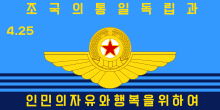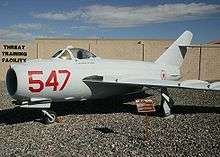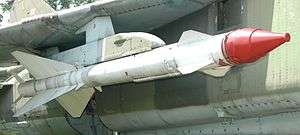Korean People's Army Air and Anti-Air Force
The Korean People's Army Air and Anti-Air Force (KPAAF; Korean: 조선인민군 항공 및 반항공군; Hanja: 朝鮮人民軍 航空軍 및 反航空軍; Chosŏn-inmin'gun hangkong mit banhangkong'gun) is the unified military aviation force of North Korea. It is the second largest branch of the Korean People's Army comprising an estimated 110,000 members.[6] It possesses 940 aircraft of different types, mostly of decades old Soviet and Chinese origin. Its primary task is to defend North Korean airspace.[7]
| Korean People's Army Air and Anti-Air Force | |
|---|---|
| 조선인민군 항공 및 반항공군 | |
 KPAAF's flag | |
| Founded | 1945 |
| Country | |
| Allegiance | |
| Type | Air force |
| Role | Aerial warfare |
| Size | 110,000 personnel 650 or 942 aircraft [2] |
| Part of | Korean People's Army |
| Garrison/HQ | Pyongyang, North Korea |
| Nickname(s) | "Korean People's Air Force", "KPAF", "KPAAF", "NKAF", "North Korean air force" "DPRKAF" |
| Engagements | Korean War Vietnam War[3] Yom Kippur War[4] |
| Commanders | |
| Commander-in-chief | General Ri Pyong-chol[5] |
| Notable commanders | VMAR Cho Myong-rok Col. Gen. Oh Gum-chol |
| Insignia | |
| Roundel |  |
| Aircraft flown | |
| Attack | Su-25 |
| Bomber | Il-28 |
| Fighter | Chengdu J-7, MiG-21, MiG-23, MiG-29 |
| Helicopter | MD Helicopters MD 500, Mil Mi-2, Mil Mi-8 Mil Mi-14, Mil Mi-24 |
| Trainer | Shenyang FT-2 |
| Transport | IL-76, An-24, An-2 |
| Korean People's Army Air and Anti-Air Force | |
| Chosŏn'gŭl | |
|---|---|
| Hancha | |
| Revised Romanization | Joseoninmingun hanggong min banhanggonggun |
| McCune–Reischauer | Chosŏn inmin'gun hangkong mit banhangkonggun |
History
The Korean People's Army Air and Anti-Air Force began as the "Korean Aviation Society" in 1945. It was organized along the lines of flying clubs in the Soviet Union. In 1946, the society became a military organization and became an aviation division of the Korean People's Army (KPA). It became a branch of the army in its own right in November 1948.[8] The KPAF incorporates much of the original Soviet air tactics, as well as North Korean experience from the UN bombings during the Korean War.
The KPAF has on occasion deployed abroad.[9] It deployed a fighter squadron to North Vietnam during the Vietnam war.[10] Kim Il-sung reportedly told the North Korean pilots "to fight in the war as if the Vietnamese sky were their own."[11]
On April 15, 1969, MiG-21s of the KPAF shot down a Lockheed EC-121 Warning Star in international waters, in the Sea of Japan.[12]
In 1973, a North Korean flight of MiG-21s deployed to Bir Arida to help defend southern Egypt during the Yom Kippur War.[13]
In 1990-91, North Korea activated four forward air bases near the Korean Demilitarized Zone (DMZ).
Organization
Capabilities
The KPAF operates a wide range of fighter and attack aircraft. North Korea is one of the few nations still operating the obsolete MiG-17, MiG-19, MiG-21 and MiG-23 fighters, yet it operates more modern and fairly capable MiG-29 fighters. The KPAF's most numerous fighter is the MiG-21, which is somewhat obsolete, but still a worthy foe in air-to-air combat, if maintained properly and crewed by experienced pilots. An assessment by US analysts GlobalSecurity.org reported that the air force "has a marginal capability for defending North Korean airspace and a limited ability to conduct air operations against South Korea."[14]
North Korea operates a wide variety of air defense equipment, from short-range MANPADS such as 9K34 Strela-3, 9K38 Igla and ZPU-4 heavy machine guns, to long-range SA-5 Gammon and Pon'gae-5 SAM systems and large-calibre AA artillery guns. North Korea has one of the densest air defence networks in the world. Ilyushin Il-28 Beagle bombers provide a medium-range attack platform, despite being generally obsolete. A large part of the ground attack aircraft are kept in heavily fortified hangars, some of which are capable of withstanding a nearby nuclear blast. Stealth capacity is known in the KPAF through researching in radar-absorbing paint and inventory deception.[15]
It has been noted that the North Korean Air Force operates a few MD-500 helicopters that were exported to the DPRK by German merchants through Soviet vessels.[16] Several were seen equipped with Soviet AT-3 anti-tank missiles during a military parade commemorating 60 years since Korean War armistice.[17] They later made another public appearance at the Wonsan Air Festival in which they were seen sporting the new green camouflage paint scheme that has also been incorporated on An-2s and Mi-17s that have also been displayed at the air show.[18]
KPAF possesses precision guided munitions such as Kh-25 and Kh-29 air to ground missiles along jamming pods such as SPS-141 for SAM suppression.[19]
Personnel
From 1978 to 1995, General Jo Myong-rok was the commander of the air force. In October 1995, he was promoted to vice-marshal and appointed Chief of the KPA General Political Bureau and a member of the Korean Workers' Party Central Military Committee. His place as commander of the Air Force was taken by Colonel General Oh Gum-chol.
Annual flying hours
The number of annual flying hours (AFH) per pilot is, like almost every other aspect of the KPAF, very hard to estimate. Most sources on the subject abstain from giving hard numbers, but all of them estimate the average annual flying hours per pilot as being 'low' to 'very low'. The number of annual flying hours is very important in estimating the individual skill and experience of the pilots of an air force: more annual flying hours suggests better trained pilots. Most estimates present a rather grim picture: AFH per pilot for the KPAF are said to be only 15 or 25[20] hours per pilot each year - comparable to the flying hours of air forces in ex-Soviet countries in the early 1990s. In comparison, most NATO fighter pilots fly at least 150 hours a year. Ground training, both in classrooms, on instructional airframes or in a flight simulator can only substitute for 'the real thing' to a certain degree, and the low number of modern jet trainers in the KPAF arsenal points to a very modest amount of flying time for the formation of new pilots.
There are a number of possible explanations for the low AFH: concern over the aging of equipment, scarcity of spare parts - especially for the older aircraft - difficulties with worn airframes, fear of defection and the scarcity of fuel are all contributing factors. It is very likely however that some 'elite' pilots and regiments receive considerably more flying hours. Especially those equipped with modern aircraft and tasked with homeland defence - like the 57th regiment flying MiG-29s and the 60th regiment flying MiG-23s - are receiving multiple times the average AFH per pilot; however, aging equipment, the scarcity of fuel and the general economic crisis in North Korea will affect these regiments as well, and keep their AFH low compared to NATO AFH.
Agence France-Presse reported on January 23, 2012, that the KPAF had conducted more flight training than average in 2011.
The Chosun Ilbo reported on March 29, 2012, that the KPAF had dramatically increased the number of flights to 650 per day.[21]
Tongil News reported on July 20, 2013, that KPAF's fighter jets and helicopters had conducted 700 sorties a day for 11 days as reported by a source in South Korean government on March 13 after Key Resolve military exercise started on March 11. 700 hours of sorties is considered by the United States military as the capability to wage all-out war.[22]
Structure
Following is a list of bases where North Korean Army Air Force aircraft are permanently based.[23][24]
Aircraft
Current inventory
.jpg)

| Aircraft | Origin | Type | Variant | In service | Notes | |
|---|---|---|---|---|---|---|
| Combat Aircraft | ||||||
| MiG-29 | Russia | multirole | -S/UB | 35[25] | ||
| MiG-21 | Soviet Union | fighter | -bis | 30[25] | ||
| MiG-23 | Soviet Union | fighter-bomber | MiG-23ML | 56[26][25] | ||
| Sukhoi Su-7B | Soviet Union | fighter-bomber | 18[25] | |||
| Sukhoi Su-25 | Soviet Union | attack | -K/UBK | 34[26][25] | ||
| Ilyushin Il-28 | Soviet Union | medium bomber | H-5 | 80[26] | Chinese-built variant designated the H-5 | |
| Shenyang F-5 | People's Republic of China | fighter | 107[25] | derivative of the MiG-17 | ||
| Shenyang J-6 | People's Republic of China | fighter | F-6 | 100[25] | license built MiG-19 | |
| Chengdu J-7 | People's Republic of China | fighter | F-7 | 120[26][25] | license built MiG-21 | |
| Transport | ||||||
| PAC P-750 | New Zealand | transport | 3[26] | illegally exported via China[27] | ||
| Antonov An-24 | Soviet Union | heavy transport | 1[26] | |||
| Helicopters | ||||||
| MD 500 | United States/DPRK | light utility | 84[26] | illegally obtained by circumventing U.S. export controls[28] | ||
| PZL Mi-2 | Polish People's Republic | utility | 47[26] | |||
| Mil Mi-8 | Soviet Union | utility | 41[26] | |||
| Mil Mi-14 | Soviet Union | ASW / SAR | 8[26] | |||
| Mil Mi-24 | Russia | attack | Mil Mi-35 | 20[26] | ||
| Mil Mi-26 | Soviet Union | transport | 4[26] | |||
| Trainer Aircraft | ||||||
| Shenyang F-5 | People's Republic of China | conversion trainer | FT-5 | 135[26] | ||
| Shenyang FT-2 | People's Republic of China | jet trainer | 30[26] | Chinese production of the MiG-15UTI | ||
| MiG-15 | Soviet Union | jet trainer | 4[26] | |||
Armament

| Name | Origin | Type | Notes | |||
|---|---|---|---|---|---|---|
| Air-to-air missile | ||||||
| AA-10 | Soviet Union | air-to-air missile | 60 medium range missiles[29] | |||
| AA-8 | Soviet Union/DPRK | air-to-air missile | 190 missiles[29] | |||
| AA-7 | Soviet Union/DPRK | air-to-air missile | 250 missiles[29] | |||
| AS-10 | Soviet Union/DPRK | air-to-air missile | ML variant.[19][30] | |||
| AS-14 | Soviet Union/DPRK | air-to-air missile | ML variant.[19][30] | |||
Equipment
| Name | Origin | Type | In service | Notes | ||
|---|---|---|---|---|---|---|
| SAM | ||||||
| KN-06 | DPRK | SAM system | 156 systems[31] | Indigenous system based on S-300 | ||
| S-200 | Soviet Union | SAM system | 75 missiles[29] | |||
| S-125 Neva/Pechora | Soviet Union/DPRK | SAM system | 300 missiles[29] | |||
| SA-7 | Soviet Union/DPRK | MANPADS | 4000 units[29] | |||
| Air Defence Artillery | ||||||
| ZSU-57-2 | Soviet Union | self-propelled | 250[29] | tracked self-propelled anti-aircraft system | ||
| ZSU-23-4 | Soviet Union | self-propelled | 248[29] | tracked self-propelled anti-aircraft system | ||
Ranks and uniforms
Ranks
The Korean People's Air Force has five categories of ranks: general officers, senior officers, junior officers, non-commissioned officers, and airmen.
Enlisted
| Equivalent NATO Code | OR-9 | OR-8 | OR-7 | OR-6 | OR-5 | OR-4 | OR-3 | OR-2 | OR-1 | |||||||||||||||||||||||||||
|---|---|---|---|---|---|---|---|---|---|---|---|---|---|---|---|---|---|---|---|---|---|---|---|---|---|---|---|---|---|---|---|---|---|---|---|---|
(edit) |
.svg.png) |
.svg.png) |
.svg.png) |
.svg.png) |
.svg.png) |
.svg.png) |
.svg.png) |
.svg.png) |
No equivalent | |||||||||||||||||||||||||||
| T'ŭkmu-sangsa 특무상사 |
Sangsa 상사 |
Chungsa 중사 |
Hasa 하사 |
Sanggŭp-pyŏngsa 상급병사 |
Chungŭp-pyŏngsa 중급병사 |
Hagŭp-pyŏngsa 하급병사 |
Chŏnsa 전사 | |||||||||||||||||||||||||||||
| Sergeant major | Master sergeant | Sergeant first class | Staff sergeant | Sergeant | Corporal | Airman first class | Airman | |||||||||||||||||||||||||||||
Officers
| Equivalent NATO code | OF-10 | OF-9 | OF-8 | OF-7 | OF-6 | OF-5 | OF-4 | OF-3 | OF-2 | OF-1 | OF(D) and student officer | |||||||||||||||||||||||||
|---|---|---|---|---|---|---|---|---|---|---|---|---|---|---|---|---|---|---|---|---|---|---|---|---|---|---|---|---|---|---|---|---|---|---|---|---|
(Edit) |
No equivalent |  |
 |
 |
 |
 |
 |
 |
 |
 |
 |
 |
 |
Unknown | ||||||||||||||||||||||
| Air force general (대장) |
Colonel general (상장) |
Lieutenant general (중장) |
Major general (소장) |
Senior colonel (대좌) |
Colonel (상좌) |
Lieutenant colonel (중좌) |
Major (소좌) |
Captain (대위) |
First lieutenant (상위) |
Second lieutenant (중위) |
Third lieutenant (소위) | |||||||||||||||||||||||||
Marshals
Occasionally KPA Air Force officers are promoted above General of the Air Force. In that case, they wear an army-style uniform, since ranks from Vice-Marshal and above are not divided into army, navy and air force.[32]
| Supreme commanders | Marshals | |||
|---|---|---|---|---|
| Ranks in Korean | Tae wonsu 대원수 | Konghwaguk Wonsu 공화국원수 | Wonsu 원수 | Ch'asu 차수 |
| Ranks | Generalissimo | Marshal of the DPRK | Marshal of the KPA | Vice Marshal |
Uniforms
Generally as a separate service in the KPA, the service wears the same KPA uniforms but with air force blue peaked caps (especially for officers) or kepi-styled caps for men and berets for women, worn with their full dress uniforms. Pilots wear helmets and flight suits when on parade and when in flight duty while air defense personnel wear the same duty dress uniforms as their ground forces counterparts but with air force blue borders on the caps.
Defections
Due to the political condition of North Korea, several North Korean pilots from the KPAF defected with their jets. These incidents include:
- On September 21, 1953, 21-year-old No Kum-sok, a senior lieutenant, flew his MiG-15 across to the South and landed at Kimpo Air Base near Seoul. Considered an intelligence bonanza, since this fighter plane was then the best the Communist bloc had. No was awarded the sum of $100,000 ($963,325.84 in 2019 dollars) and the right to reside in the United States. He is now a U.S. citizen.
- On August 5, 1960, a Shenyang J-5 landed at Kimpo, the second time a J-5 appeared in South Korea. This aircraft was kept by South Korea and was briefly flown in South Korean markings before being scrapped.
- In February 1983, Lee Ung-pyong used a training exercise to defect and landed his Shenyang J-6 at an airfield in Seoul. According to the then common practice, he received a commission in the South Korean Air Force (ROKAF), eventually becoming a colonel and teaching at the South Korean academy until his death in 2002. He received a reward of 1.2 billion South Korean won.
- On May 23, 1996, Captain Lee Chul-su defected with another Shenyang J-6, number 529, to Suwon Air Base, South Korea. He reportedly left behind his wife and two children. Lee was rewarded 480 million South Korean Won (approx. 400 thousand US dollars). He is now a colonel in the ROKAF and is an academic instructor.[33]
See also
- Air Koryo
- Jebi Sports Group, football club of the KPAF
- Korean People's Army
- North Korean Ground Force
- North Korean Navy
- Republic of Korea Air Force
References
- "North Korean military takes oath of loyalty". www.enca.com. Archived from the original on 2016-09-17. Retrieved 2016-09-10.
- "Flightglobal - World Air Forces 2015 (PDF)" (PDF). Flightglobal.com. Archived (PDF) from the original on 2014-12-19. Retrieved 2015-06-07.
- Richard M Bennett. "Missiles and madness". Asia Times. Archived from the original on 2011-09-01. Retrieved 2011-08-11.
- David Cenciotti. "Israeli F-4s Actually Fought North Korean MiGs During the Yom Kippur War". Business Insider. Retrieved 2019-03-27.
- One report claimed that General Ri Pyong-chol was executed in August 2014; George Petras, North Korea executions under Kim Jong Un Archived 2017-09-05 at the Wayback Machine USA Today, 2016-02-10
- North Korea Country Study Archived 2005-02-26 at the Wayback Machine, pp. 18-19
- "KPAF". GlobalSecurity.org. Archived from the original on 2006-09-13. Retrieved 2006-09-14.
- Edwards, Paul M. (2010). "Korean People's Air Force (KPAF)". Historical Dictionary of the Korean War (2nd ed.). Lanham: Scarecrow Press. p. 151. ISBN 978-0-8108-7461-9.
- Bennett, Richard (August 18, 2006). "Missiles and madness". Asia Times. Retrieved October 17, 2017.
- Gady, Franz-Stefan War of the Dragons: Why North Korea Does Not Trust China September 29, 2017 Archived September 30, 2017, at the Wayback Machine The Diplomat Retrieved September 29, 2017
- Gluck, Caroline N Korea admits Vietnam war role July 7, 2001 Archived March 8, 2008, at the Wayback Machine BBC News Retrieved September 30, 2017
- "N Korea in 'US spy plane' warning". 11 June 2006. Archived from the original on 6 March 2018. Retrieved 5 March 2018 – via news.bbc.co.uk.
- Leone, Dario. "An unknown story from the Yom Kippur war: Israeli F-4s vs North Korean MiG-21s". The Aviationist. Archived from the original on 7 April 2014. Retrieved 4 April 2014.
- Pike, John. "Korean People's Army Air Force - North Korea". Archived from the original on 2006-09-13. Retrieved 2006-09-14.
- "North Korea 'develops stealth paint to camouflage fighter jets'". 23 August 2010. Archived from the original on 16 September 2014. Retrieved 5 April 2018 – via www.telegraph.co.uk.
- Roblin, Sebastien (13 October 2017). "The Strange Story of How North Korea Smuggled in 87 U.S. Scout Helicopter". War Is Boring.
- Cenciotti, David (30 July 2013). "North Korea's (illegally supplied) armed Hughes 500E helicopters emerge after 30 years in the dark". The Aviationist.
- Filmer, Paul (30 September 2016). "Airshow Review – Wonsan Air Festival, North Korea". Global Aviation Resource.
- https://www.businessinsider.com/photo-north-korean-fighter-jet-missile-after-kim-base-visit-2020-4
- Intelligence experts analyse 'North Korean fighter jet crash' Archived 2017-09-09 at the Wayback Machine, The Telegraph, 18 August 2010
- "N.Korea Steps Up Air Force Training Flights". The Chosun Ilbo (English Edition) archived at archive.org. 2012-03-29. Archived from the original on March 30, 2012. Retrieved 2013-03-24.
North Korea has stepped up the number of training flights since last month to as many as 650 sorties a day. The North Korean air force is conducting training flights even on weekends [...]
- 하루 700회 출격한 북한군 항공기. Tongil News (in Korean). 20 July 2013.
- North Korean Special Weapons Facilities Archived 2006-07-15 at the Wayback Machine, Federation of American Scientists, 2006.
- North Korean Air Forces, Scramble, Dutch Aviation Society, 2006. Archived January 17, 2010, at WebCite
- Jo, Haena (10 February 2020). "Flying against the odds: North Korea's air force". International Institute for Strategic Studies. Retrieved 28 February 2020.
- "World Air Forces 2020". FlightGlobal Insight. 2020. Retrieved 10 February 2020.
- "Pacific Aerospace guilty of planning unlawful export to North Korea". Stuff. 11 Oct 2017.
- "North Korea's Illegally Supplied Helicopters Emerge". businessinsider.com. Retrieved 5 June 2015.
- Trade Registers. Armstrade.sipri.org. Retrieved on 29 May 2015
- https://theaviationist.com/2020/04/14/rare-photo-of-north-korean-mig-29-firing-an-r-60-aam-emerges-after-kim-jong-uns-visit-to-sunchon-airbase/
- "KN-06 (Pon'gae-5)". Missile Threat. Retrieved 2020-07-27.
- Tertitskiy, Fyodor (March 14, 2017). "North Korea's baffling personalized rank insignia, explained". NK News. Archived from the original on March 19, 2017.
- "NK pilot defector promoted to colonel". 16 November 2010. Archived from the original on 25 November 2010. Retrieved 16 November 2010.
External links
| Wikimedia Commons has media related to Air force of North Korea. |
- The North Korean Air Force by Google Earth: a compilation of Google Earth images of North Korean fighters, bombers, ground attack aircraft, transports, and special-operations aircraft
- Korean People's Air Force Victory record by Jan Josef Safarik